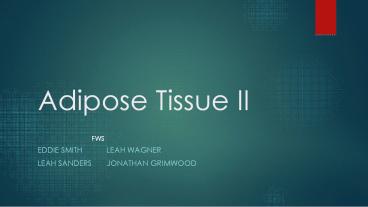Adipose Tissue II - PowerPoint PPT Presentation
1 / 11
Title:
Adipose Tissue II
Description:
Adipose Tissue II FWS EDDIE SMITH LEAH WAGNER LEAH SANDERS JONATHAN GRIMWOOD How is adipose stored? Energy ingested as fat beyond what is needed by the body is stored ... – PowerPoint PPT presentation
Number of Views:111
Avg rating:3.0/5.0
Title: Adipose Tissue II
1
Adipose Tissue II
FWS
- Eddie Smith Leah Wagner
- Leah Sanders Jonathan Grimwood
2
How is adipose stored?
- Energy ingested as fat beyond what is needed by
the body is stored in adipose tissue. - Carbohydrates and proteins can be converted to
fat - Carbohydrates are stored in the form of glycogen
in the liver and muscle - Carbohydrates can also be converted to
triglycerides in the liver, then transferred to
adipose tissue for storage
http//www.sportsci.org/encyc/adipose/adipose.html
3
How does it get there to be stored?
- When fat is ingested via the diet
- Emulsified by bile acids in the intestine
- Fat and cholesterol packaged into chylomicrons
- Chylomicrons pass into the lymph system and then
into the blood - Enzymes (lipoproten lipase) break the fats into
fatty acids - Enzyme activity depends on levels of insulin in
the body - High insulin lipases are highly active
- Low insulin lipases are inactive
- Adipose, muscle and liver cells take up
triglycerides from chylomicrons - Chylomicron gradually becomes smaller and is
absorbed by the liver
http//www.med.upenn.edu/biocbiop/faculty/vanderko
oi/chap7-9.pdf
4
How does it get there to be stored?
- When fat is made in the liver
- Fat, in the form of triglycerides or cholesterol,
is exported by a lipoprotein - Very Low Density Lipoprotein (VLDL) mainly
composed of fat - VLDL circulates through blood and triglycerides
are removed as fat moves into adipose tissue - As it gets smaller, it becomes LDL
- Low Density Lipoprotein (LDL) high amount of
cholesterol - With high amounts of LDL in the blood,
individuals are at a higher risk for vascular
diseases as it forms plaque and foam cells in the
arteries.
http//www.med.upenn.edu/biocbiop/faculty/vanderko
oi/chap7-9.pdf
5
How does it get there to be stored?
- High Density Lipoprotein (HDL) moves cholesterol
from tissues to liver - Once in the liver, the cholesterol becomes part
of the cholesterol pool in the liver
http//www.med.upenn.edu/biocbiop/faculty/vanderko
oi/chap7-9.pdf
6
Cholesterol Levels
7
How is adipose formed and grown?
- When calories in gt calories out
- Adipose cells grow similar to other cells in the
body - Hyperplasia increase in the number of adipose
cells - Hypertrophy increase in the size of adipose
cells - Once new adipose cells are formed, they remain
throughout life and can only reduce in size. - Genetics and diet effect the contributions of
these two mechanisms
http//www.sportsci.org/encyc/adipose/adipose.html
8
How do you adjust adipose?
- Fat is a required nutrient for optimal health
- Intake should not excess 35 of total calories
- Know your fats saturated vs unsaturated
http//www.extension.iastate.edu/humansciences/fat
9
How do you adjust adipose?
- Saturated fats
- Solid at room temperature
- Come from animal sources (butter, milk, meat)
- Consumed in moderation, increased levels create
high cholesterol levels - Unsaturated fats
- Monounsaturated and polyunsaturated
- Liquid at room temperature
- Come from plant sources (vegetable olive oil,
avocado, nuts) - Benneficial to health, helps to lower cholesterol
levels
http//www.extension.iastate.edu/humansciences/fat
999--2004
10
How do you adjust adipose?
- A third group of fatty acids to note
- Trans fatty acids
- When unsaturated fats are changed making it solid
- Commonly found in processed foods
- Similar to saturated fats
http//www.extension.iastate.edu/humansciences/fat
11
How do you adjust adipose?
- To maintain a healthy weight
- Eat a balanced diet
- Appropriate amounts of carbohydrates, fat, and
protein - Do not eat excessively
- Most people require 1,500-2,000 calories a day
- Exercise regularly































